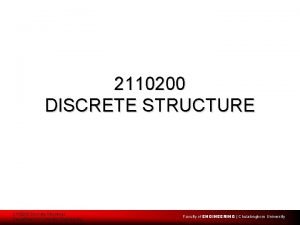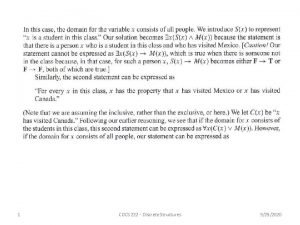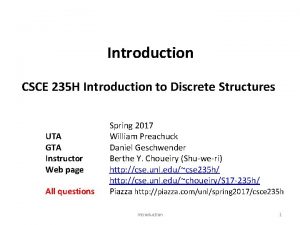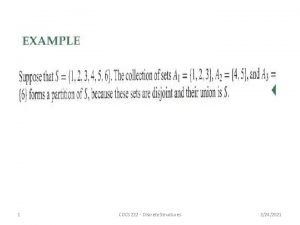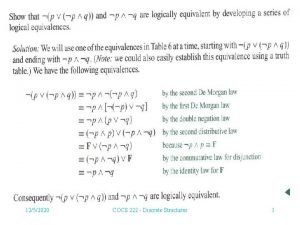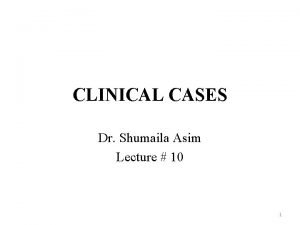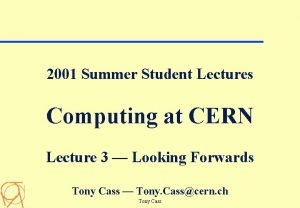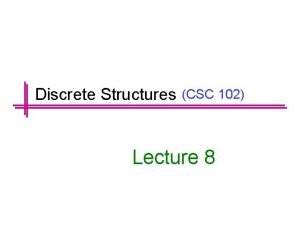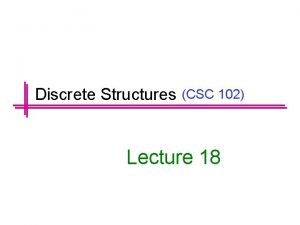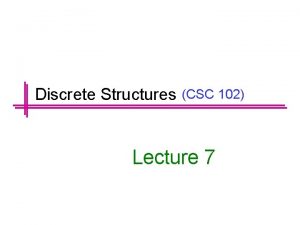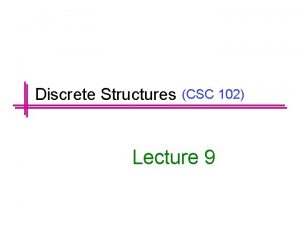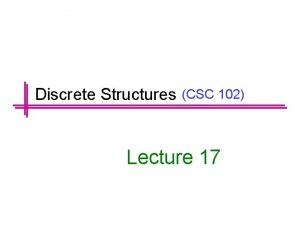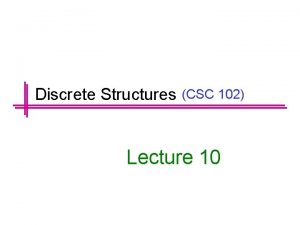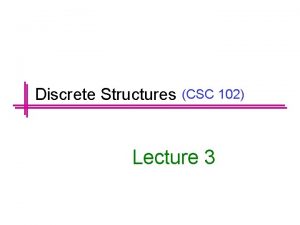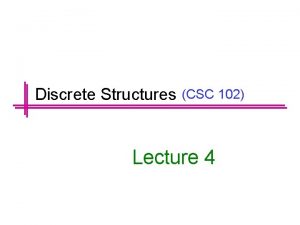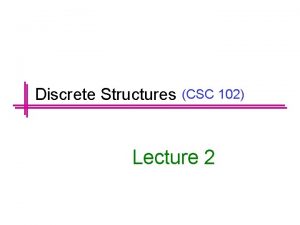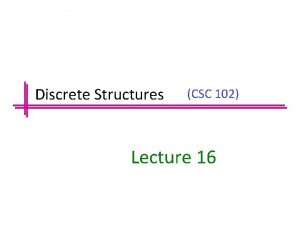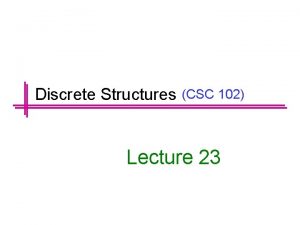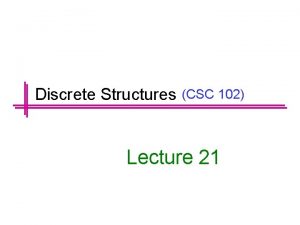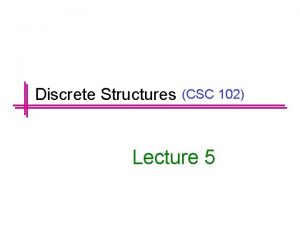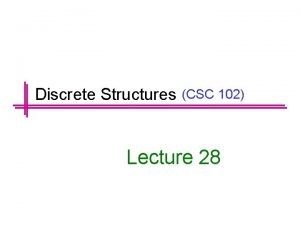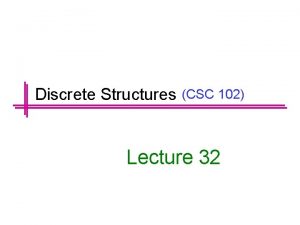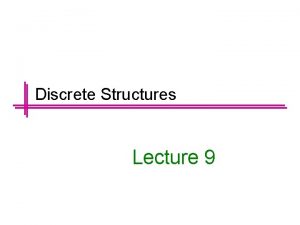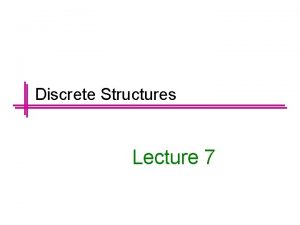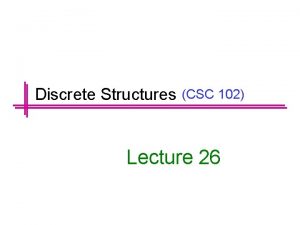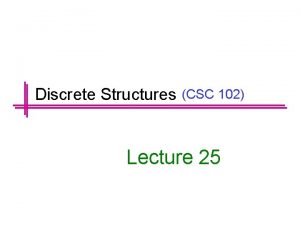Discrete Structures CSC 102 Lecture 14 Previous Lectures
























- Slides: 24

Discrete Structures (CSC 102) Lecture 14

Previous Lectures Summary v Why study set Theory v Sets v Operations on sets v Memberships v Notations v Venn diagrams

Introductions to Set Theory II

Today's Lecture v Procedural Versions v Properties of Sets v Empty Set Properties v Difference Properties v Set Identities v Boolean Algebra and Set theory v Puzzles

Procedural Versions of Set Definitions Let X and Y be subsets of a universal set U and suppose x and y are elements of U. 1. x ∈ X ∪ Y ⇔ x ∈ X or x ∈ Y 2. x ∈ X ∩ Y ⇔ x ∈ X and x ∈ Y 3. x ∈ X − Y ⇔ x ∈ X and x ∉ Y 4. x ∈ X ⇔ x ∉ X’ 5. (x, y) ∈ X × Y ⇔ x ∈ X and y ∈ Y

Properties of Sets Theorem: 1. Inclusion of Intersection: For all sets A and B, A ∩ B ⊆ A and (b) A ∩ B ⊆ B. 2. Inclusion in Union: For all sets A and B, A ⊆ A ∪ B and (b) B ⊆ A ∪ B. 3. Transitive Property of Subsets: For all sets A, B, and C, if A ⊆ B and B ⊆ C, then A ⊆ C.

Proof 1. (For all sets A and B), A ∩ B ⊆ A. Suppose x is an element in A ∩ B and then you show that x is in A. To say that x is in A ∩ B means that x is in A and x is in B. This allows you to complete the proof by deducing that, in particular, x is in A, as was to be shown. Note that this deduction is just a special case of the valid argument form p∧q ∴ p. Similarly we will done with others…. .

Set Identities Let all sets referred to below be subsets of a universal set U. 1. Commutative Laws: For all sets A and B, (a) A ∪ B = B ∪ A and (b) A ∩ B = B ∩ A. 2. Associative Laws: For all sets A, B, and C, (a) (A ∪ B) ∪ C = A ∪ (B ∪ C) and (b) (A ∩ B) ∩ C = A ∩ (B ∩ C). 3. Distributive Laws: For all sets, A, B, and C, (a) A ∪ (B ∩ C) = (A ∪ B) ∩ (A ∪ C) and

Cont…. (b) A ∩ (B ∪ C) = (A ∩ B) ∪ (A ∩ C). 4. Identity Laws: For all sets A, (a) A ∪ ∅ = A, (b) A ∩ U = A. 5. Complement Laws: (a) A ∪ A′ = U, (b) A ∩ A′ = ∅. 6. Double Complement Law: For all sets A, (A′)′ = A. 7. Idempotent Laws: For all sets A, (a) A ∪ A = A, (b) A ∩ A = A. 8. Universal Bound Laws: For all sets A, (a) A ∪ U = U, (b) A ∩ ∅ = ∅.

Cont…. 9. De Morgan’s Laws: For all sets A and B, (a) (A ∪ B)′ = A′ ∩ B′ (b) (A ∩ B)′ = A′ ∪ B′. 10. Absorption Laws: For all sets A and B, (a) A ∪ (A ∩ B) = A, (b) A ∩ (A ∪ B) = A. 11. Complements of U and ∅: (a) U′ = ∅ (b) ∅′ = U. 12. Set Difference Law: For all sets A and B, A − B = A ∩ B′.

A Distributive Law for Sets For all sets A, B, and C, A ∪ (B ∩ C) = (A ∪ B) ∩ (A ∪ C). Proof: Suppose A and B are sets. We have to show A ∪ (B ∩ C) ⊆ (A ∪ B) ∩ (A ∪ C). Suppose x ∈ A ∪ (B ∩ C). By definition of union, x ∈ A or x ∈ B ∩ C. Case 1 (x ∈ A): Since x ∈ A, then x ∈ A ∪ B by definition of union and also x ∈ A ∪ C by definition of union. Hence x ∈ (A ∪ B) ∩ (A ∪ C) by definition of intersection. Case 2 (x ∈ B ∩ C): Since x ∈ B ∩ C, then x ∈ B and x ∈ C by definition of intersection. Since x ∈ B, x ∈ A ∪ B and since x ∈ C, x ∈ A ∪ C, both by definition of union. Hence x ∈ (A ∪ B) ∩ (A ∪ C) by definition of intersection. In both cases, x ∈ (A ∪ B) ∩ (A ∪ C). Hence A ∪ (B ∩ C) ⊆ (A ∪ B) ∩ (A ∪ C) ………… (1)

Cont…. Now we have to show (A ∪ B) ∩ (A ∪ C) ⊆ A ∪ (B ∩ C) Suppose x ∈ (A ∪ B) ∩ (A ∪ C). By definition of intersection, x ∈ A ∪ B and x ∈ A ∪ C. Consider the two cases x ∈ A and x ∉ A. Case 1 (x ∈ A): Since x ∈ A, we can immediately conclude that x ∈ A ∪ (B ∩ C) by definition of union. Case 2 (x ∉ A): Since x ∈ A ∪ B, x is in at least one of A or B. But x is not in A; hence x is in B. Similarly, since x ∈ A ∪ C, x is in at least one of A or C. But x is not in A; hence x is in C. We have shown that both x ∈ B and x ∈ C, and so by definition of intersection, x ∈ B ∩ C. It follows by definition of union that x ∈ A ∪ (B ∩ C). In both cases x ∈ A ∪ (B ∩ C). Therefore, (A ∪ B) ∩ (A ∪ C) ⊆ A ∪ (B ∩ C) ………. (2) Hence A ∪ (B ∩ C) = (A ∪ B) ∩ (A ∪ C).

Proof of De Morgan’s Law for Sets Prove that for all sets A and B, (A∪B)′ = A′ ∩ B′. Proof: Suppose x ∈ (A ∪ B)′. That is x ∉ A ∪ B. But to say that x ∉ A ∪ B means that it is false that (x is in A or x is in B). By De Morgan’s laws of logic, this implies that x is not in A and x is not in B, which can be written x ∉ A and x ∉ B. Hence x ∈ A′ and x ∈ B′ by definition of complement. It follows, by definition of intersection, that x ∈ A′ ∩ B′. So (A ∪ B) ′ ⊆ A′ ∩ B′ by definition of subset.

Cont… Suppose x ∈ A′ ∩ B′. intersection, x ∈ A′ and x ∈ B′, and by definition of complement, x ∉ A and x ∉ B. In other words, x is not in A and x is not in B. By De Morgan’s laws of logic this implies that it is false that (x is in A or x is in B), which can be written x ∉ A ∪ B by definition of union. Hence, by definition of complement, x ∈ (A ∪ B)′. It follows that A′ ∩ B′ ⊆ (A ∪ B)′ by definition of subset.

The Empty Set Theorem: If E is a set with no elements and A is any set, then E ⊆ A. Proof: Suppose not. Suppose there exists a set E with no elements and a set A such that E A. Then there would be an element of E that is not an element of A But there can be no such element since E has no elements. This is a contradiction. [Hence the supposition that there are sets E and A, where E has no elements and E A, is false, and so theorem is true. ]

Uniqueness of the Empty Set • There is only one set with no elements. Proof: Suppose E 1 and E 2 are both sets with no elements. E 1 ⊆ E 2. since E 1 has no elements. Also E 2 ⊆ E 1 since E 2 has no elements. Thus E 1 = E 2 by definition of set equality. • A Set with No Elements Is a Subset of Every Set. Proof: If E is a set with no elements and A is any set, then E ⊆ A. Suppose there exists a set E with no elements and a set A such that E A. Then there would be an element of E that is not an element of A. But there can be no such element since E has no elements. This is a contradiction.

A Proof for a Conditional Statement Prove that for all sets A, B, and C, if A ⊆ B and B ⊆ C′, then A ∩ C = ∅. Proof: Suppose A, B, and C are any sets such that A ⊆ B and B ⊆ C′. We must show that A ∩ C = ∅. Suppose not. That is, suppose there is an element x in A ∩ C. By definition of intersection, x ∈ A and x ∈ C. Then, since A ⊆ B, x ∈ B by definition of subset. Also, since B ⊆ C′, then x ∈ C′ by definition of subset again. It follows by definition of complement that x ∉ C. Thus x ∈ C and x ∉ C, which is a contradiction. So the supposition that there is an element x in A ∩ C is false, and thus A ∩ C = ∅ [as was to be shown].

Finding a Counterexample for identities • For all sets A, B, and C, (A − B) ∪ (B − C) = A − C. Counterexample 1: Let A = {1, 2, 4, 5}, B = {2, 3, 5, 6}, and C = {4, 5, 6, 7}. Then A − B = {1, 4}, B − C = {2, 3}, and A − C = {1, 2}. Hence (A − B) ∪ (B − C) = {1, 4} ∪ {2, 3} = {1, 2, 3, 4}, whereas A − C = {1, 2}. Since {1, 2, 3, 4} ≠ {1, 2}, we have that (A − B) ∪ (B − C) ≠ A − C. Counterexample 2: Let A = ∅, B = {3}, and C = ∅. Then A − B = ∅, B − C = {3}, and A − C = ∅. Hence (A − B) ∪ (B − C) = ∅∪{3} = {3}, whereas A − C = ∅. Since {3} ≠ ∅, we have that (A − B) ∪ (B − C) ≠ A − C.

Deriving a Set Difference Property Construct an algebraic proof that for all sets A, B, and C, (A ∪ B) − C = (A − C) ∪ (B − C). Proof: Let A, B, and C be any sets. Then (A ∪ B) − C = (A ∪ B) ∩ C′ by the set difference law = C′ ∩ (A ∪ B) by the commutative law for ∩ = (C′ ∩ A) ∪ (C′ ∩ B) by the distributive law = (A ∩ C′) ∪ (B ∩ C′) by the commutative law for ∩ = (A − C) ∪ (B − C) by the set difference law.

Cont… Construct an algebraic proof that for all sets A and B, A − (A ∩ B) = A − B. Proof: Suppose A and B are any sets. Then A − (A ∩ B) = A ∩ (A ∩ B)′ by the set difference law = A ∩ (A’ ∪ B′) by De Morgan’s laws = (A ∩ A′) ∪ (A ∩ B′) by the distributive law = ∅∪(A ∩ B′) by the complement law = (A ∩ B′) ∪ ∅ by the commutative law for ∪ = A ∩ B′ by the identity law for ∪

Boolean Algebra and Set Theory

Cont….

Barber puzzle In a certain town there is a male barber who shaves all those men, and only those men, who do not shave themselves. Question: Does the barber shave himself? Solution: Neither yes nor no. If the barber shaves himself, he is a member of the class of men who shave themselves. But no member of this class is shaved by the barber, and so the barber does not shave himself. On the other hand, if the barber does not shave himself, he belongs to the class of men who do not shave themselves. But the barber shaves every man in this class, so the barber does shave himself.

Lecture Summary v Procedural Versions v Properties of Sets v Empty Set Properties v Difference Properties v Set Identities v Boolean Algebra and Set theory v Paradoxes
 Csc 102 introduction to problem solving
Csc 102 introduction to problem solving 01:640:244 lecture notes - lecture 15: plat, idah, farad
01:640:244 lecture notes - lecture 15: plat, idah, farad Discrete structures
Discrete structures Cs 584
Cs 584 What is discrete math
What is discrete math Discrete structures
Discrete structures Discrete computational structures
Discrete computational structures Mathematics 1
Mathematics 1 Discrete structures
Discrete structures Homologous structures definition
Homologous structures definition Hematology medicine student lectures
Hematology medicine student lectures C programming and numerical analysis an introduction
C programming and numerical analysis an introduction Power system lectures
Power system lectures Rick trebino lectures
Rick trebino lectures Digital logic design lectures
Digital logic design lectures How to get the most out of lectures
How to get the most out of lectures Ludic space
Ludic space Comsats virtual campus lectures
Comsats virtual campus lectures Theory of translation lectures
Theory of translation lectures Reinforcement learning lectures
Reinforcement learning lectures Uva orthopaedics
Uva orthopaedics Gpoint c++
Gpoint c++ Rbc formation stages
Rbc formation stages Dr asim lectures
Dr asim lectures Cern summer school lectures
Cern summer school lectures


